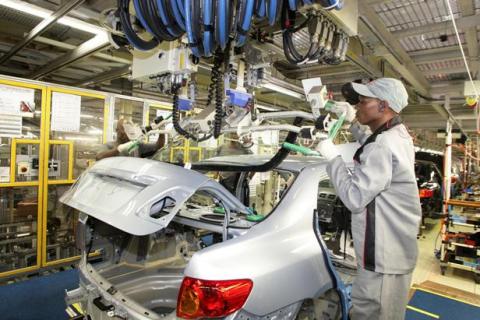A report by the Oxford Business Group (OBG) has indicated that Ghana’s manufacturing sector holds promise in the future, although global outlook continues to be bleak.
The report cited that disruptions in supply chains brought on by the pandemic were initially driven by the knock-on- effects of factory closures in China.
However, as the pandemic spread, declines in demand and rising costs of logistics due to global trade and economic slowdowns added to the struggles faced by industry stakeholders.
While industry as a whole was negatively affected by the pandemic, certain subsectors such as textiles, processed food and pharmaceuticals were better placed to cushion the impact. A total of 36 1D1F projects, jointly funded by the government and financial institutions to encourage import substitution, commenced in mid-2020.
The construction sector is projected to improve in the fourth quarter of 2020 with 58 small-scale processing factories under the Enable Youth 1D1F banner, with funding from the African Development Bank. Government subsidies and relief programmes have also helped factories so they could maintain production levels.
Even so, foreign investment flows into the manufacturing sector are gaining momentum. For instance, in August Volkswagen opened its first assembly plant in Ghana, a facility in Accra with capacity for 5000 Amarok, Caddy, Passat, Polo, Teramont and Tiguan models per year. Meanwhile, other international automakers are expected to follow suit, including Nissan, Sinotruck and Totyota.
Thus, by all indications, Ghana’s manufacturing sector is tipped to keep its trajectory of improvement. As attractive as Ghana continues to look, given the strategic position it continues to hold as an export centre in West Africa, Ghana’s industry is expected to get better considering the commencement of trade under the African Continental free Trade Area.
Eyeballing Global manufacturing production in the third quarter
The United Nations Industrial Development Organization (UNIDO), in a recent report has revealed that world manufacturing production bounced back in the third quarter of 2020 after underperforming in the first and second quarters, however, the outlook is quite uncertain due to a resurgence of the COVID-19 pandemic in most countries.
In the third quarter of 2020, most of the economies showed signs of recovery, albeit with an unclear future, as a number of industrialized countries were experiencing a second wave of coronavirus from October 2020 onwards.
According to the report, global manufacturing output declined by 1.1 percent in a year-on-year comparison due to COVID-19 containment measures, following a massive drop of 11.1 percent in the second quarter of 2020.
Industrialized economies recorded a decline in manufacturing production of 5.9 percent in the third quarter of 2020, after a contraction of 16.3 percent in the previous quarter.
The world’s largest manufacturer, China, was also hit hard by the pandemic in the first quarter of 2020, but its manufacturing sector has experienced a rebound. China’s manufacturing output increased by 8.2 percent in a year-on-year comparison in the third quarter of 2020, following a growth rate of 3.2 percent in the second quarter.
More so, manufacturing production in developing and emerging economies (excluding China) showed a decline of 3.7 percent and 22.0 percent in output in the third and the second quarters of 2020, respectively.
Asia and the Pacific reported in the third quarter of 2020 a drop in manufacturing output of 5.3 percent, following a reduction of 23.3 percent in the previous quarter, in a year-on-year comparison.
On the whole, the report indicates that the challenges and uncertainties that dominated previous quarters, such as trade protectionist measures as well as uncertainty around Brexit, have clearly surfaced again, thus impeding the recovery experienced from a global view point.
READ ALSO: 25% of Business Executives forecast growth in revenue in 2021




















